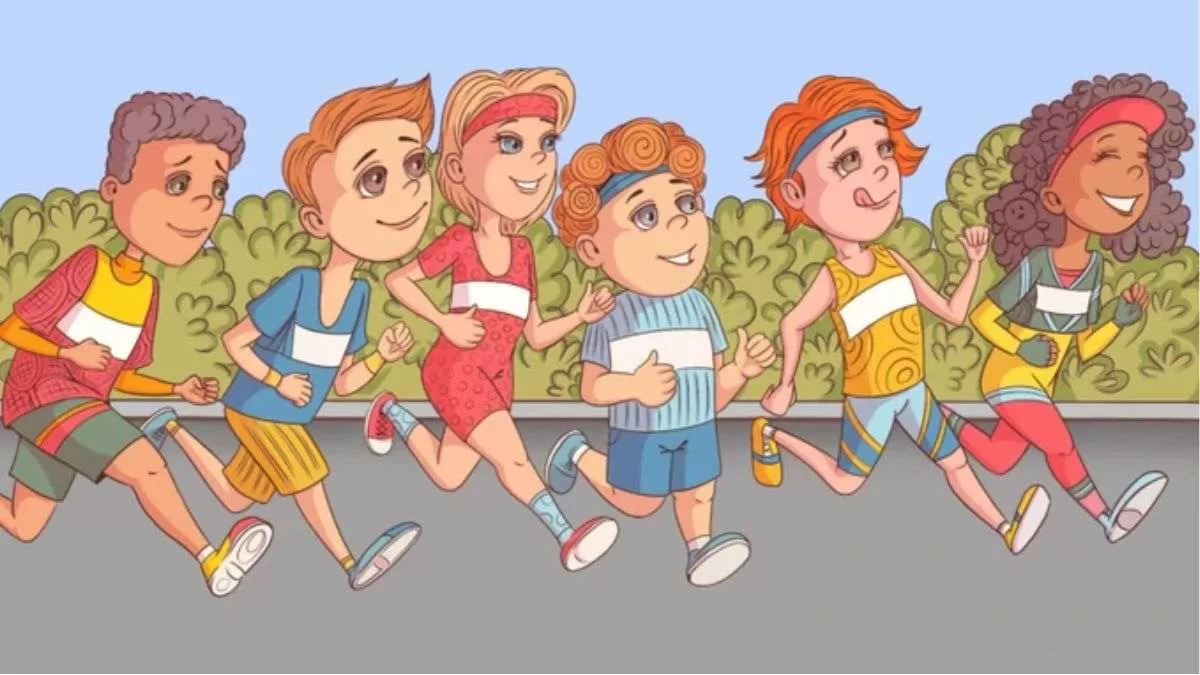Optical illusions have long fascinated and perplexed the human mind, captivating our imagination with their ability to deceive our senses.
From the ambiguous figures of the Rubin vase to the mesmerizing motion of the spinning dancer, these illusions challenge our perception and reveal the intricate workings of the brain.
Among the myriad of optical illusions, one particular challenge has gained prominence: spotting hidden images within seemingly ordinary pictures.
In this article, we delve into the world of hidden images and present a captivating optical illusion: the quest to spot the hidden teddy bear within a children’s racing picture in just 11 seconds.
The Intriguing Challenge:

Imagine yourself presented with a vibrant picture depicting a children’s racing scene.
At first glance, it appears to be a delightful illustration capturing the energy and excitement of a playful competition.
However, concealed within this seemingly innocuous image lies a hidden treasure: a teddy bear cleverly camouflaged amidst the flurry of activity.
Your task? To spot this elusive bear within a mere 11 seconds. But beware, for the bear is cunningly disguised, requiring keen observation and rapid cognitive processing to uncover its whereabouts.
The Psychology Behind Optical Illusions:
Before embarking on our quest to locate the hidden teddy bear, it is imperative to understand the psychology behind optical illusions.
At the core of these illusions lies the intricate interplay between perception and cognition.
Our brains are adept at processing visual information, often making rapid assessments based on incomplete or ambiguous cues.
However, this efficiency comes at a cost, as our perception is prone to biases and distortions, leading us to perceive reality in ways that may not necessarily align with objective truth.
One of the key mechanisms at play in optical illusions is known as “perceptual grouping,” wherein our brains organize visual stimuli into meaningful patterns or shapes.
This innate tendency to impose structure onto chaos can lead us to perceive hidden images within complex scenes, even when they are not explicitly present.
Additionally, factors such as contrast, color, and spatial arrangement influence our perception, further enhancing the illusionary effect.
The Role of Attention and Time Constraints:
In the quest to spot hidden images, attention plays a pivotal role.
Our ability to selectively focus on relevant details amidst a sea of distractions determines our success in unraveling the illusion.
Moreover, time constraints add an element of urgency to the challenge, placing pressure on our cognitive faculties to process information rapidly and efficiently.
The 11-second time limit imposed in our optical illusion challenge serves as both a constraint and a catalyst for cognitive processing.
Within this brief window of opportunity, participants must harness their attentional resources and deploy strategic visual scanning techniques to discern the hidden bear amidst the bustling race scene.
The challenge thus becomes not only a test of perceptual acuity but also a race against the clock.
Strategies for Success:
Navigating the intricacies of optical illusions requires a combination of perceptual acumen and cognitive agility.
To increase your chances of success in spotting the hidden teddy bear, consider employing the following strategies:
Focus Your Attention: Direct your gaze towards areas of high salience within the image, such as areas of contrast or unusual patterns.
By prioritizing relevant visual cues, you can optimize your chances of detecting the hidden bear.
Use Peripheral Vision: Peripheral vision plays a crucial role in detecting subtle changes or anomalies within a scene.
Expand your visual field to encompass the entire picture, allowing peripheral cues to guide your search for the hidden image.
Employ Gestalt Principles: Gestalt psychology principles, such as proximity, similarity, and closure, offer valuable insights into how our brains organize visual information.
Apply these principles to discern cohesive patterns or shapes within the image, which may lead you closer to uncovering the hidden bear.
Practice Visual Scanning: Adopt a systematic approach to visual scanning, moving your gaze methodically across the image in search of potential hiding spots.
By breaking down the scene into smaller segments and scanning each area systematically, you can cover more ground efficiently.
The Journey to Discovery:
As you embark on your quest to spot the hidden teddy bear, immerse yourself fully in the experience, allowing your curiosity and imagination to guide your exploration.
With each passing second, observe the intricacies of the racing scene unfold before your eyes, attuned to the subtle nuances that may betray the bear’s presence.
Perhaps you’ll catch a glimpse of a telltale silhouette nestled among the crowd of racing children, or maybe a flash of fur amidst the flurry of motion.
Stay vigilant and trust in your instincts, for within the chaos lies the key to unlocking the illusionary puzzle.
Conclusion:
In the realm of optical illusions, the quest to spot hidden images serves as a testament to the remarkable capabilities of the human mind.
By challenging our perception and cognitive processing abilities, these illusions offer a glimpse into the inner workings of the brain, highlighting the delicate balance between sensation and interpretation.
As you contemplate the intricacies of the hidden teddy bear challenge, remember that the journey itself holds as much value as the destination.
Whether you succeed in spotting the elusive bear within the allotted 11 seconds or not, cherish the experience of engaging with the illusionary magic that surrounds us.
For in the pursuit of understanding lies the true beauty of the enigmatic world of optical illusions.
